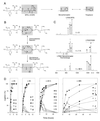Protein synthesis by native chemical ligation: expanded scope by using straightforward methodology
- PMID: 10468563
- PMCID: PMC17843
- DOI: 10.1073/pnas.96.18.10068
Protein synthesis by native chemical ligation: expanded scope by using straightforward methodology
Abstract
The total chemical synthesis of proteins has great potential for increasing our understanding of the molecular basis of protein function. The introduction of native chemical ligation techniques to join unprotected peptides next to a cysteine residue has greatly facilitated the synthesis of proteins of moderate size. Here, we describe a straightforward methodology that has enabled us to rapidly analyze the compatibility of the native chemical ligation strategy for X-Cys ligation sites, where X is any of the 20 naturally occurring amino acids. The simplified methodology avoids the necessity of specific amino acid thioester linkers or alkylation of C-terminal thioacid peptides. Experiments using matrix-assisted laser-desorption ionization MS analysis of combinatorial ligations of LYRAX-C-terminal thioester peptides to the peptide CRANK show that all 20 amino acids are suitable for ligation, with Val, Ile, and Pro representing less favorable choices because of slow ligation rates. To illustrate the method's utility, two 124-aa proteins were manually synthesized by using a three-step, four-piece ligation to yield a fully active human secretory phospholipase A(2) and a catalytically inactive analog. The combination of flexibility in design with general access because of simplified methodology broadens the applicability and versatility of chemical protein synthesis.
Figures


References
Publication types
MeSH terms
Substances
Grants and funding
LinkOut - more resources
Full Text Sources
Other Literature Sources

